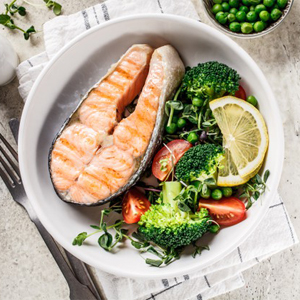FISH provides another class of high-protein or tissue-building food. As this term is generally understood, it includes both vertebrate fish that is, fish having a backbone such as salmon, cod, shad etc. and many other water animals such as lobsters, crabs, shrimp, oysters and clams. Fish can usually be purchased at a lower price than many other food items and for this reason possesses an economic advantage over them. Some varieties of fish are sought more than others, the popularity of certain kinds depending on the individual taste or the preference of the people in a particular locality.
As is well known, fish is an extremely perishable food. Therefore, when it is caught in quantities too great to be used at one time, it is preserved in various ways. The preservation methods that have proved to be the most satisfactory are canning, salting and drying, smoking and
preserving in various kinds of brine and pickle. As such methods are usually carried out in the locality where the fish is caught, many varieties of fish can be conveniently stored for long periods of time and so distributed as to meet the requirements of the consumer. This plan enables persons far removed from the Source of supply to procure fish frequently.
COMPOSITION AND CLASSES OF FISH
In general, the composition of fish is similar to that of meat, for both of them are high-protein foods. However, some varieties of fish contain large quantities of fat and others contain very little of this substance, so the food value of the different kinds varies greatly. As in the case of meat, fish is lacking in carbohydrate. Because of the close similarity between these two foods, fish is a very desirable substitute for meat. In fish, as well as in shell fish, a very large proportion of the food substances present is protein. This proportion varies with the quantity of water, bone, and refuse that the particular food contains, and with the physical structure of the food. The percentage of fat in fish varies from less than 1 per cent in some cases to a trifle more than 14 per cent in others. This variation affects the total food value proportionately. The varieties of fish that contain the most fat deteriorate most rapidly and withstand transportation the least. Fish containing a large amount of fat such as salmon, turbot, eel, herring, halibut, mackerel, mullet, butterfish and lake trout have a more moist quality than those which are without fat such as cod. Like meat, fish does not contain carbohydrate in any appreciable quantity. In fish, mineral matter is quite as prevalent as in meat.
Classes of Fish
According to the quantity of fat it contains, fish may be divided into two classes, Dry, or lean fish, and Oily fish. Cod, haddock, smelt, flounder, perch, bass, brook trout, and pike are dry, or lean fish. Salmon, shad, mackerel, herring, eel, halibut, lake trout, and white fish are oily fish. This latter group contains from 5 to 10 per cent of fat.
Fish may also be divided into two classes, according to the water in which they live, fish from the sea being termed ‘salt-water fish’, and those from rivers and lakes are ‘fresh-water fish’.
FOOD VALUE OF FISH
The total food value of fish, as has been shown, is high or low, varying with the food substances it contains. Therefore, since weight for weight, the food value of fat is much higher than that of protein, it follows that the fish containing the most fat has the highest food value. Fat and protein, as is well known, do not serve the same function in the body, but each has its purpose and is valuable and necessary in the diet. So far as the quantity of protein is concerned, fish are valuable in their tissue-forming and tissue-building qualities. Nutritive value of fish may be lost in its preparation, if proper methods are not applied. To obtain as much food value from fish as possible, the various points that are involved in its cookery must be thoroughly understood. When the value of fish as a food is to be determined, its digestibility must receive definite consideration. Much depends on the way it is cooked. The ease with which fish is digested is influenced largely by the quantity of fat it contains. In addition to the correct cooking of fish and the presence of fat, a factor that largely influences the digestibility of this food is the length of the fibers of the flesh. It will be remembered that the parts of an animal having long fibers are tougher and less easily digested than those having short fibers.
PREPARATION OF FISH FOR COOKING
It is important to determine whether or not fish is fresh. Fish should not give off any offensive odor. The eyes should be bright and clear not dull or sunken. The gills should have a bright-red color and there should be no blubber showing. The flesh should be so firm that no dent will be made when it is touched with the finger. Fish may also be tested for freshness by placing it in a pan of water. If it sinks it may be known to be fresh, but if it floats it is not fit for use. Fish is usually prepared for cooking at the market where it is purchased, but frequently a fish comes into the home just as it has been caught. In order to prepare such a fish properly for cooking, one must understand how to clean it. If fish is purchased in unclean condition, it should be cleaned at once. The first step for cleaning fish consists in removing the scales. With the fish scaled, proceed to remove the entrails. Make sure that the cavity formed by taking out the entrails is perfectly clean. Then cut off the head, fins and tail if desired and wash it in cold water. In the preparation of some kinds of fish, it is often desired to bone the fish; that is, to remove the backbone and the ribs. Some kinds of fish, especially those having no scales such as flounder, catfish and eels are made more palatable by being skinned. Many recipes require fish to be cut into fillets, that is, thick and flat slices from which the bone is removed.
The fish which is now properly prepared, may be cooked at once or placed in the refrigerator until time for cooking. Salted slightly inside and out, it should be kept in a covered enamel or porcelain dish and then put in the compartment of the refrigerator from which odors cannot be carried to foods in the other compartments.
METHODS OF COOKING FISH
Fish may be boiled, steamed, baked, fried, broiled or sauted. The effect of these different methods is exactly the same on fish as on meat, since the two foods are the same in general construction. The cookery method to select depends largely on the size, kind, quality and flavor of the fish. Just as an old chicken with well-developed muscles is not suitable for broiling, so a very large fish should not be broiled unless it can be cut into slices, steaks or thin pieces. Some varieties of fish are more or less tasteless. These should be prepared by a cookery method that will improve their flavor or if the cooking fails to add flavor, a highly seasoned or highly flavored sauce should be served with them. The acid of vinegar or lemon seems to assist in bringing out the flavor of fish, so when a sauce is not used, a slice of lemon is often served with the fish.




